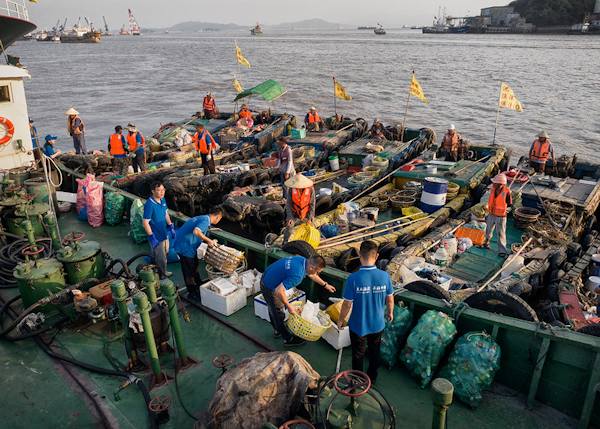SEJournal Online is the digital news magazine of the Society of Environmental Journalists. Learn more about SEJournal Online, including submission, subscription and advertising information.
 |
 |
| Workers on plastic waste collection boats in Zhejiang province on China's east coast in 2023. Photo: UNEP via Flickr Creative Commons (CC BY-NC-SA 2.0). |
Issue Backgrounder: Will the Coming Plastics Treaty Solve the Problem Or Enshrine It?
By Joseph A. Davis
 |
To hear some tell it, this will be the year the world finally solves the plastics pollution problem. Don’t bet the ranch on it.
Representatives of 170 nations will meet Nov. 25-Dec. 1 in Busan, South Korea, to finalize a global treaty aimed at controlling plastic pollution. The odds for true success range from bleak to low.
It will be the fifth negotiating session under the auspices of the United Nations Environment Programme, or INC-5, for Intergovernmental Negotiating Committee. The fourth session (INC-4), April 2024 in Ottawa, gave some clues about what to expect.
More than 2,500 delegates participated in INC-4, the largest meeting yet, representing 170 nations — but over 480 “observer” organizations, a category which includes lobby groups from the plastic industry — which is a branch of the petrochemical industry.
The key issue, environmental groups say,
is whether to set legally binding limits
on production of plastics. The plastics
industry says that would be disastrous.
The key issue, environmental groups say, is whether to set legally binding limits on production of plastics. The plastics industry says that would be disastrous.
ProPublica’s Lisa Song attended the Ottawa session and ended up writing a piece noting how industry representatives (and industry messaging) dominated it. She reported that journalists often got far less access to the proceedings than lobbyists. Despite the “plastics-free” wrappings (no plastic sleeve on meeting badges), industry messaging was everywhere.
The plastics industry will also be there at the INC-5 meeting. We predict that the Great Pacific Garbage Patch will also still be there after the meeting.
A global problem
The issue matters because discarded plastics litter U.S. streets and parks. Because plastic products have negative effects on human (and ecosystem) health that we are only beginning to understand. Because plastics in the environment break down into ever-smaller particles that not only enter the human body but permeate every corner of the planet.
It matters because microplastics were found in every sample of human semen tested in a recent study. They have also been found in human breast milk. It matters because plastic pollution of the planet may very well be a bell that can’t be unrung.
Plastics are global in their impact, not only because of the Pacific Garbage Patch but because plastic waste is an internationally traded commodity.
Before 2017, China was importing a big share of the world’s exported plastic waste. As much as 56% of it. A lot of it from Europe and the United States. But in that year (really, building over the whole decade), China banned the import of plastic waste.
Well, to be more precise, it banned even those plastic waste imports that were virtually uncontaminated by other waste. Turns out: That is almost the whole problem in a nutshell.
Even if you meticulously wash and sort your
plastic waste, it is usually contaminated.
This makes it expensive to recycle —
and thus close to useless.
Look in your blue recycling bin. Even if you meticulously wash and sort your plastic waste, it is usually contaminated: by bottle-top bands, by labels, by dyes, by adhesives, etc. This makes it expensive to recycle — and thus close to useless.
After the Chinese ban, the world market for plastic waste shifted. U.S. firms that had been exporting waste to China for (ostensible) recycling had to come up with another solution. One solution was to send it to other willing Asian and Southeast Asian nations: Sri Lanka, Malaysia, Vietnam or Indonesia.
Remember that only 10 rivers, most in Asia or Southeast Asia, contribute 90 percent of the plastics in the oceans.
Where plastics come from
To simplify a lot of complex chemistry, the feedstocks that most plastics are made of ultimately come from crude oil, natural gas and, to a lesser extent, coal.
Because of climate change, there is significant worldwide pressure to reduce the production and combustion of these fossil fuels. This would harm the oil and gas industries (and their petrochemical offspring) economically.
So, increased production of plastics looks like a lifeline to the oil and gas industry as a market for their products. They have a strong motive to increase it.
These are the people who are sending lobbyists to the INC-5 treaty talks. As a general matter, what they are lobbying against is a legally binding cap on the production of plastics.
The “recycling” issue
Some voluminous forms of municipal waste, especially paper, glass and metals like aluminum, are well-suited for recycling. Many municipalities do just that. But not plastics.
Did you know that only about 9% of the plastic waste produced globally is recycled? That’s according to a 2022 OECD study. In the United States, the amount could be higher, but it has been falling since the Chinese waste ban. In 2014, it was officially estimated at 9.5%. But today it has fallen to about 5%, at least according to Greenpeace.
While you might expect Greenpeace to lowball the number, it does not build confidence to know that the official U.S. Environmental Protection Agency estimates are based partly on figures from the American Chemistry Council. And the EPA only goes up to 2018.
It turns out that more waste plastic in the U.S. is incinerated (16.3%) than is recycled.
‘Clean’ incineration?
Incineration is not really a clean solution to the plastic waste problem. Burning plastics creates toxic substances — such as dioxins, furans, mercury and polychlorinated biphenyls — and releases them into the atmosphere. Not to mention other unhealthful pollution like particulates and climate-warming carbon dioxide.
The EPA still grants permits for municipal solid waste incinerators, even if it hopes to phase them out. Permitted incinerators rely (theoretically) on ultrahigh temperatures to destroy the worst toxics, but they do not always work as they are supposed to.
There may be special reasons to incinerate some waste categories, such as medical waste, where pathogens are a concern. But medical waste is mostly plastics and there are other, safe ways to dispose of it.
It doesn’t really help that the EPA labels some incinerators as “waste-to-energy” facilities when they recover some of the energy produced. Environmentalists (and downwind neighbors) don’t like them. But municipalities — and some industries — often do. Journalists must ask if incinerator operators are putting lipstick on a pig.
The problem with pyrolysis
Nowadays, we have seen the emergence of another option: “advanced” or “chemical” recycling. The terms can refer to a wide range of technologies, but in most cases, they involve pyrolysis, solvents, enzymes and even sound waves to break down plastics.
But it’s mostly pyrolysis, which involves subjecting plastic waste to high temperatures in the absence of oxygen, breaking down their large molecules into smaller ones.
The petrochemical industry likes
and advocates chemical recycling.
Environmentalists, not so much.
The resulting products are essentially petrochemicals, which can then be burned as fuel (emitting carbon). The pyrolysis itself creates emissions as well. The petrochemical industry likes and advocates chemical recycling. Environmentalists, not so much. More lipstick; more pigs.
That leaves landfill disposal. Most plastic waste in the U.S. still goes into landfills. It’s that or into the environment (where plenty goes). Much political energy goes into the idea that we should keep it out of landfills (which are regulated to minimize pollution). News media give a lot of credence to the idea.
True: Some jurisdictions are running out of room in landfills. But many have lots of room. Ask which is better — putting it into the landfill or into the ocean?
The media war and the coming plastics treaty
If you turn on the TV in the Washington, D.C., media market, you will see a lot of cheery ads from “America’s Plastic Makers.” All of them sing the glories of plastic and praise plastic “recycling.”
If you look a little deeper, you will find that this entity is a wing of the American Chemistry Council, which is the lobby group for the petrochemical industry. As long as the American public believes plastic can be recycled, it can grow its business (and stay in business).
Nobody has yet discovered how much they spend on these media campaigns. But it’s got to be a lot.
And the coming plastics treaty is probably one major reason for it.
There now actually is a draft text for the treaty, but almost nobody is happy with it. The big issue is whether the treaty will ask nations to make legally binding commitments to reduce their production of plastic in the first place. The petrochemical industry opposes this, hoping for decades of further growth to offset any climate-related shrinkage of the market for fossil fuels.
But if you look at the draft, or whatever treaty text emerges, you might want to keep in mind all the ways in which the Paris climate accord has gone off the tracks (or threatens to).
It’s a good time to ask questions:
Will nations really agree this year? Will lobby groups dominate the nations at the meeting? Is the treaty really legally binding? Will enough nations really ratify it? Will the U.S.? Will it let nations set their own voluntary goals? Will there be true transparency about how well nations are living up to it? Will it turn into an obligation for payments from rich countries to poor ones? How will it be enforced?
Get ready — there will be a lot to report on in coming years.
[Editor's Note: Find out more about the early negotiations on the international plastics treaty and read a BookShelf review about the history of plastics. For more about ocean plastics, here's a Feature on the persistence of ocean plastics, a TipSheet on the problem of plastic straws as marine litter, plus our Topic on the Beat with other top water and ocean stories and our Covering Climate Solutions: Ocean package. For more on plastics generally, see a TipSheet on its role in waste incineration, and read this Issue Backgrounder on styrofoam and earlier TipSheets on styrofoam bans and plastics recycling.]
Joseph A. Davis is a freelance writer/editor in Washington, D.C. who has been writing about the environment since 1976. He writes SEJournal Online's TipSheet, Reporter's Toolbox and Issue Backgrounder, and curates SEJ's weekday news headlines service EJToday and @EJTodayNews. Davis also directs SEJ's Freedom of Information Project and writes the WatchDog opinion column.
* From the weekly news magazine SEJournal Online, Vol. 9, No. 27. Content from each new issue of SEJournal Online is available to the public via the SEJournal Online main page. Subscribe to the e-newsletter here. And see past issues of the SEJournal archived here.













 Advertisement
Advertisement 



